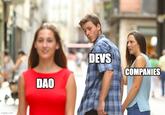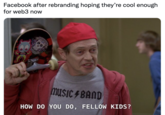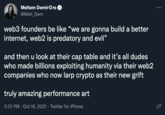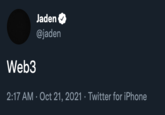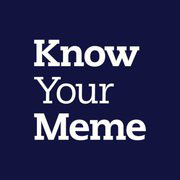Web3
Part of a series on The Internet. [View Related Entries]
[View Related Sub-entries]
This submission is currently being researched & evaluated!
You can help confirm this entry by contributing facts, media, and other evidence of notability and mutation.
About
Web3, also known as Web 3.0 or the Semantic Web, is a new development in the way the internet operates that's slowly been conceptualized and developed since the early 2000s. In a Web 3.0 model of the internet, the HTML-based World Wide Web, which is also called Web 2.0 / Web2, would be decentralized and not operated through specific companies and websites which control user data directly, like social media platforms and search engines, among others. A Web3 model would be decentralized using a global web of data consisting of machines that are able to process complex semantics in human language to better optimize how different pieces of data are connected in regards to similar subject matter.
History
Proposition
The term "Semantic Web" was first coined and conceptualized in 2001 by the man who invented the World Wide Web, Tim Berners-Lee.[1] He defined the "Semantic Web" as "a web of data that can be processed directly and indirectly by machines". This type of web "processed directly and indirectly by machines" differs from the current Web 2.0 model in that the current Web 2.0 model is written and deciphered through HTML and run through specific companies that control data. HTML consists of bodies of text interspersed with images. The main limitation of this HTML-based internet that a Web3 model would dismantle is that Web 2.0 is only able to link pieces of meta-data by specific keywords written in the HTML and is only able to access data if the specific company/website allows it to be accessed. When searching for a specific keyword, Web 2.0 search engines are limited to the keyword. However, in a Web 3.0 model, the system of machines aiding in the search is able to rely on a set of learned semantics that is broader than a keyword.[2]
Early Development
Although the semantic web or Web3 was being conceptualized as early as 2001, it wasn't until the invention and implementation of both Git in 2005 and Bitcoin in 2009 that a decentralized internet and systems of computing were beginning to appear possible. Git established how codebase systems could be decentralized.[5] Bitcoin established how currency can exist without any central authority, contrasting a centralized network like Paypal.[3] Also notably, the cryptocurrency Ethereum was created in 2013, which has become another currency that proves more directly that Blockchain cryptocurrencies can aid as building blocks for building decentralized systems going forward.[3]
In June 2016, the first Decentralized Web Summit[4] was organized and held, where speakers like Tim Berners-Lee and Mitchell Baker, the leader of Mozilla companies, spoke about Web3. The summit's "Call to Action" was advertised as "The Decentralized Web aims to make the Web open, secure and free of censorship by distributing data, processing, and hosting across millions of computers around the world, with no centralized control". A video of Berners-Lee speaking at the event is shown below.
Creation of Solid
In September 2018, Berners-Lee announced a decentralized system of web data he and a team of developers at MIT had been working on called Inrupt. Inrupt would be the decentralized foundation of machines operating a new internet system his team had built named Solid.[6] The Solid system works by holding all of one user's information or data. Tech news outlet Fast Company explained the system as "like a mashup of Google Drive, Microsoft Outlook, Slack, Spotify, and WhatsApp". Instead, however, of all these essentials to internet engagement existing under different companies storing the data, they all exist for one user within what is called their "Pod". A user's "Pod" of their own data including their text messages, contacts, music playlists, streaming videos, etc., are all under their own control to let the greater body of meta-data to have access to or not. Berners-Lee is stated in the Fast Company article as being inspired to act on the Solid project in response to Facebook's mishandling of user data which continued into 2021.[6] Instead of user data being used to sell more products like how Facebook uses it, user data would instead be used to better user experience on the internet under Solid.
Development of Web3 DAOs
If specific apps and companies like Google or Facebook are not Web3 compatible, then a question is, how are companies or capitalism going to operate under a Web3 model? How will people be employed under a Web3 model? DAOs (or Decentralized Autonomous Organizations) are the answer to this question and embody how "dapps" (or decentralized apps) will be run in Web3.[8] DAOs operate as a group organized around a mission that coordinates through a shared set of rules enforced on a blockchain.[9] These DAOs pay their developers based on a "token economy" where the DAO incentives motivated developers from around the world to work for their project by releasing x number of tokens, giving 10% to the early builders, putting 10% for sale to the public, and set the rest aside for future payment of contributors and funding of the project.[8] This system of tokens and DAOs eliminates the current Web 2.0 model of getting VC funding which can oftentimes come with one-sided incentives in the best interest of the funders rather than the developers or the general public. In general, DAOs began appearing in 2018 as a result of the Solid network being conceptualized.
Online Interest
On Reddit, the earliest meme about Web3 was posted to the r/ProgrammerHumor subreddit[15] on August 5th, 2019. The meme (shown below) received 255 upvotes over the course of three years. Additionally, the r/web3[16] subreddit was created in May 2009 and has roughly 2,800 members as of October 2021.

More Web3 memes were made in 2020, specifically for an article written by Golem Project[17] in May 2020. The author for the article made three separate Chad memes to describe different types of Web3 developers (shown below).
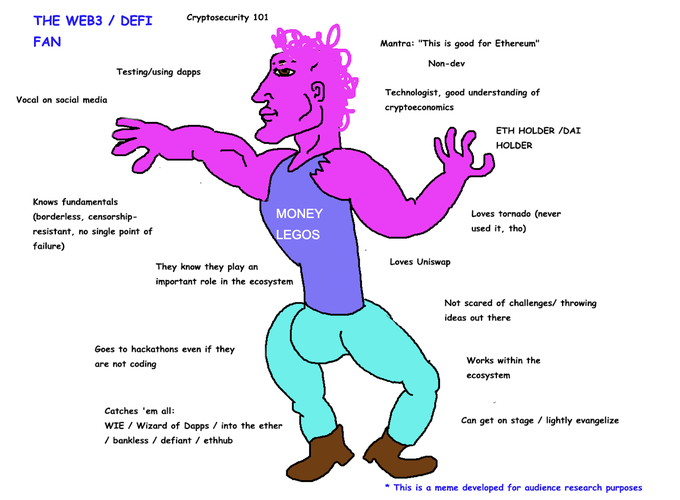
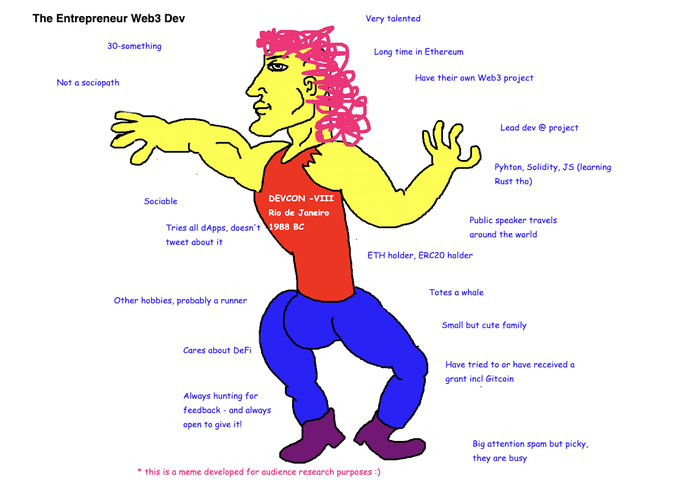
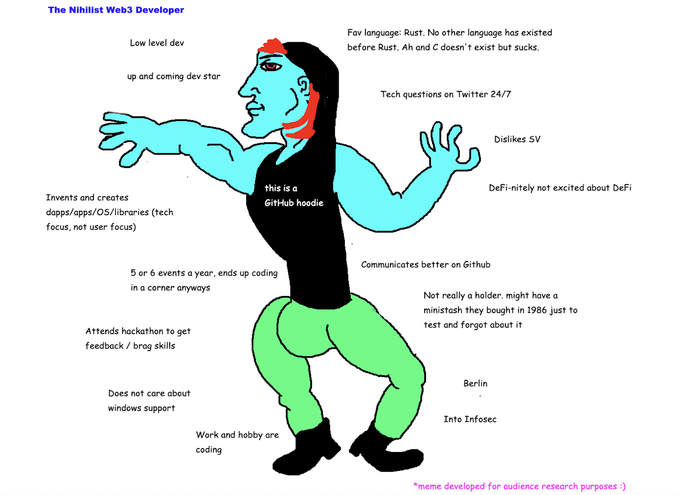
Meme-interest in Web3 started most notably in 2021, however. This was caused by a few things including but not limited to increased interest in NFTs and the continued mishandling of user data by big companies such as Facebook, who in April 2021, accidentally leaked roughly 533 million records of user data.[7] In October 2021, Facebook announced that it would be rebranding itself by changing its company name to reflect its future focus on the metaverse.[10]
As an example of increased interest in Web3 in 2021 as a meme reference, tweets about Web3 didn't begin to reach over 1,000 likes until October 2021. For instance, on October 12th, 2021, Twitter[11] user @brunobar79 tweeted the first known Web3 meme on the platform to reach over 1,000 likes. The tweet (shown below) received roughly 3,300 likes over the course of ten days.

Also on October 12th, Gary Vee tweeted[12] about Web3, receiving roughly 1,200 likes for his tweet. More Twitter users began to use Web3 as a reference, many sparked by Facebook's rebranding announcement. For instance, Twitter[13] user @zhusu quote tweeted an article detailing the Facebook rebrand, captioning it "This is how scared web2 is of web3". The tweet (shown below, left) received roughly 1,500 likes over the course of two days. Additionally, on October 20th, Twitter[14] user @evabeylin received the most amount of likes to date of a tweet using Web3 as a meme reference. The tweet (shown below, right) received roughly 4,700 likes over the course of two days.


Web3 received an increased amount of attention on TikTok starting in 2021. On January 17th, 2021, TikToker[18] @deanthinker uploaded the first viral instance of a creator talking about Web3 on the platform. The TikTok (shown below, left) received roughly 66,300 plays and 7,600 likes over the course of ten months. Additionally, the most viral TikTok talking about Web3 was posted on October 10th, 2021, by TikToker[19] @ittaisvidler (shown below, right) who received roughly 911,700 plays and 53,200 likes over the course of twelve days. As of October 21st, 2021, #web3 [20] has roughly 4.8 million views on the platform.
https://www.tiktok.com/embed/v2/6918620817253223686
https://www.tiktok.com/embed/v2/7017508119328656646
Search Interest
_
External References
[1] Scientific American – The Semantic Web
[2] Wikipedia – Limitations of HTML
[3] TechCrunch – A decentralized web would give power back to the people online
[4] Internet Archive – Decentralised Web Summit
[5] Kinsta – What Is GitHub? A Beginner’s Introduction to GitHub
[6] Fast Company – Tim Berners-Lee tells us his radical new plan to upend the World Wide Web
[7] Wired – "What Really Caused Facebook's 500M-User Data Leak?": https://www.wired.com/story/facebook-data-leak-500-million-users-phone-numbers/
[8] FreeCodeCamp – What is Web3?
[9] Mirror – A beginner’s guide to DAOs
[10] The Verge – Facebook is planning to rebrand the company with a new name
[11] Twitter – @brunobar79
[14] Twitter – @evabeylin
[15] Reddit – r/ProgrammerHumor
[17] Golem Project – 2020 memes
[18] TikTok – @deanthinker
[19] TikTok – @ittaisvidler

